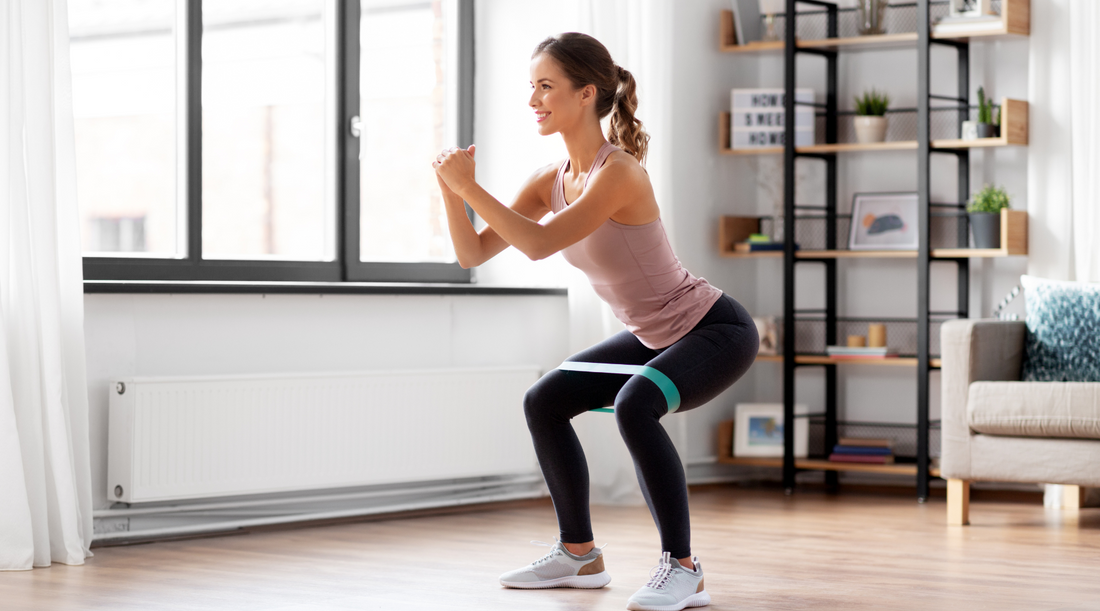Home workouts with resistance bands have been around for a while and aren’t just a recent fad. Due to the pandemic restrictions, many daily activities, including exercise, have shifted to home settings. Building strength and muscle doesn’t always require lifting the bulkiest gym weights. Instead, resistance bands offer a space-efficient and portable alternative, providing tension to the muscles.
Resistance bands offer varying resistance levels through the entire range of motion. In contrast to free weights, which exert a constant force, the tension in bands intensifies as they are stretched. This mirrors the natural strength curve observed in numerous exercises. Additionally, resistance bands facilitated a diverse array of exercises that target different muscle groups. They boast a joint-friendly design, and their resistance can be effortlessly modified by adjusting length, and thickness, combining multiple bands, or increasing the resistance by following the color codes of resistance bands. These qualities make resistance bands an optimal choice for home workouts.
Why Opt Resistance Band Exercises at Home
Our home likely provides the optimal environment for workouts. The convenience, comfort, and familiarity make it an ideal space. Moreover, you avoid the need to wait for others to finish using equipment, ensuring a seamless and efficient workout experience.
Engaging in home exercises with resistance bands is not only convenient but also cost-effective requiring minimal investment compared to purchasing weights or gym memberships. To delve deeper into the significance of at-home resistance band exercises, let us explore the well-known benefits.
Space Efficiency
Resistance or exercise bands boast a compact and lightweight design, easily foldable or coiled—making them an excellent choice for individuals with limited workout spaces or residing in smaller homes. Their portability is a key feature, allowing users to conveniently store them in a drawer, toss them in a gym bag, or include them in a suitcase while traveling. Moreover, the space efficiency of resistance bands goes beyond storage considerations. When incorporating bands into exercises like squats or lunges, the need for an expansive space is eliminated, rendering them perfect for home workouts in space-constrained environments. With resistance bands, maintaining a consistent fitness routine becomes achievable without compromising on space.
Versatility and Adaptability
Workout bands derive their versatility from their capacity to focus on diverse muscle groups and accommodate a broad spectrum of exercises. Whether you’re working to fortify your legs, sculpt your arms, or activate your core, resistance bands provide a versatile solution. These bands are available in various resistance levels, enabling users to gradually intensify their workouts as their fitness levels advance. This adaptability renders them suitable for individuals at different stages of their fitness journey, spanning from beginners to seasoned athletes. Additionally, they seamlessly integrate into traditional exercises, bringing an extra dimension of challenge to the workout routine.
Joint-Friendly

Known as “tension bands”, resistance bans are celebrated for their joint-friendly attributes, characterized by unique properties that minimize stress and impact on joints during workloads. In contrast to heavy weights or machines, which may exert excessive pressure on joints, resistance bands offer a smooth and controlled resistance across the entire range of motion.
The elastic nature of these bands enables a gradual increase in tension, decreasing the risk of sudden jolts or stains on joints. This quality makes them especially advantageous for individuals dealing with joint issues, arthritis, or those on the path to recovery from injuries. It also allows users to tailor the intensity of their workouts, ensuring that joints are not unnecessarily burdened.
Progress Tracking
Monitoring progress in exercise band workouts can be achieved through various effective methods. Gradually transitioning to higher resistance bands serves as a clear indicator of increased strength and endurance. The step-by-step nature of resistance band exercises allows individuals to track their development over time. As individuals consistently integrate these bands into routines, they can observe enhancements in factors such as the number of repetitions, exercise duration, or the complexity of movements. Another method involves adjusting tension; users can tailor the intensity of their workouts by selecting elastic workout bands with different resistance levels. As strength and stamina improve, opting for more robust bands ensures a continuous challenge, providing a tangible sign of progress.
Essential Resistance Band Exercises to Do at Home
Front Squats

Squats can be incorporated into resistance band core exercises to engage not only the lower body but also activate muscles in the abdominal region. Specifically, front squats target the rectus abdominis (abs) and obliques, providing a comprehensive workout for the core. Additionally, front squats activate lower body muscles, including the quadriceps, obliques, and glutes.
How to:
- Stand on the center of the training band, ensuring your feet are hip-width apart, and grasp one end of the band with both hands
- Bend your arms to bring your hands up alongside your ears, and elevate your elbows until your triceps are parallel to the floor, maintaining a close and narrow position. This marks your starting position.
- While keeping your arms stationary, activate your core and bend at the knees, lowering your hips back and down until your thighs are parallel to the floor.
- Push through your feet to straighten your legs and return to a standing position.
Standing Bicep Curl

One of the basic resistance band bicep exercises is the standing bicep curl. This workout primarily engages the bicep branchii muscles, located at the front of the upper arm, and these muscles play a crucial role in elbow flexion during the bicep curl exercise.
How to:
- Stand on the resistance band with your feet shoulder-width apart, and grip both ends with your hands.
- Maintain an upright position with a straight back and head, lift your chest, and engage your core. Keep your elbows close to the sides close to sides of your torso.
- Lift your hands upward in a curling motion, ensuring that your elbows remain stationary with no forward or backward movement.
- Hold the position for about one second, then slowly bring your hands back down.
Lat Pulldown

One of the diverse resistance band exercises for the back is the banded lat pulldown. Typically using resistance band handles and door anchors, this exercise focuses on the muscles in the upper back, specifically targeting the latissimus dorsi (lats). It mimics the motion of a traditional lat pulldown machine commonly seen in gym settings.
How to:
- Secure a resistant band with handles above your head using a door anchor, then grasp both handles with your palms facing forward. Lower yourself to your knee to extend the band and generate tension
- Activate your glutes, tighten your abs, and retract your shoulders downward and backward.
- Maintain the contraction for a brief moment, then gradually release both ends of the band while exhaling. Fully extend your arms, ensuring you avoid protruding your shoulders near the top.
- Take another deep breath and tug on both ends of the band.
Glute Bridges

Resistance band hip exercises are a prevalent component of resistance band workout routines. One fundamental exercise is the glute bridge, which engages the glutes, hip flexors, lower back muscles, and quadriceps.
How to:
- Lay down on an exercise mat with your feet flat on the floor, and your knees bent at a 90-degree angle, pointing upward.
- Place a resistance band across your hips and pin it down to the ground by holding each side with your hands.
- Lift your hips upward until a straight line is created from your knees to your shoulders.
- Hold this stretched position for one second before gradually lowering your hips back down to the starting position.
There are many resistance band workouts available and you might find some provided by the company or store where you bought your workout bands. However, before delving into any resistance band exercises, it's crucial to define your fitness goals. Tailor your routine to align with these goals and seamlessly integrate it into your daily life. Create a diverse workout routine by combining various exercises for a comprehensive and effective approach.
Effective Resistance Band Workout with the Right Bands

Beyond the comfort, convenience, and privilege of home workouts, the effectiveness of your resistance band exercise routine should be a top consideration. Numerous resources provide routines, and various shops such as Super Exercise Band offer a wider selection of resistance bands to choose from. However, to execute a routine you must prioritize maintaining proper form and technique to maximize benefits and prevent injuries. Investing in a heavy-duty resistance band ensures the quality necessary for any exercise. Begin with lower resistance levels and progressively increase to challenge your muscles over time. Understanding resistance band color coding ensures you select the right band with the appropriate resistance level. Keep your workouts interesting by incorporating various resistance band exercises to avoid monotony.
Armed with these tips and the right resistance band, you are ready to tone those muscles and shed those unwanted pounds. Secure the right resistance band form Super Exercise band and kickstart your home workout journey today. Consider getting a beginner or travel kit for a comprehensive resistance band routine. Alternatively, opt for bulk resistance bands to stock up as you work towards your fitness goals. Don’t forget to acquire accessories for setups and to add variety to your routine. If you are upgrading from a previous resistance band, ensure you purchase the right color-coded band.
Seize a band and reach for your fitness goals with Super Exercise Band.
The content provided on this blog is for informational purposes only and is not intended as professional medical advice. The information shared here should not be used to diagnose or treat any health problems or illnesses without consulting a qualified healthcare
professional. Always seek the advice of your physician or other qualified healthcare provider with any questions you may have regarding a medical condition. Never disregard professional medical advice or delay in seeking it because of something you have read on this blog. Reliance on any information provided by this blog is solely at your own risk.

